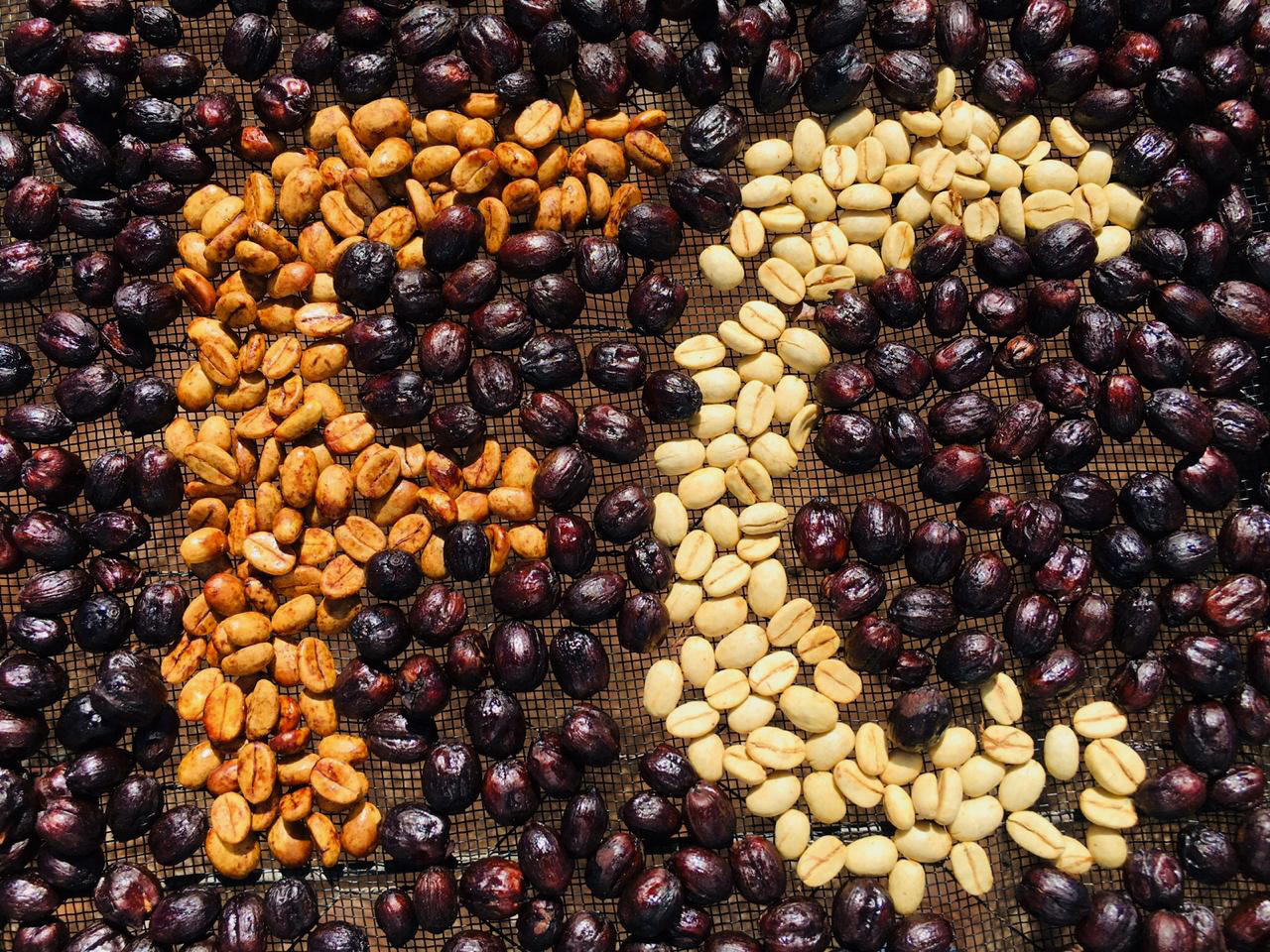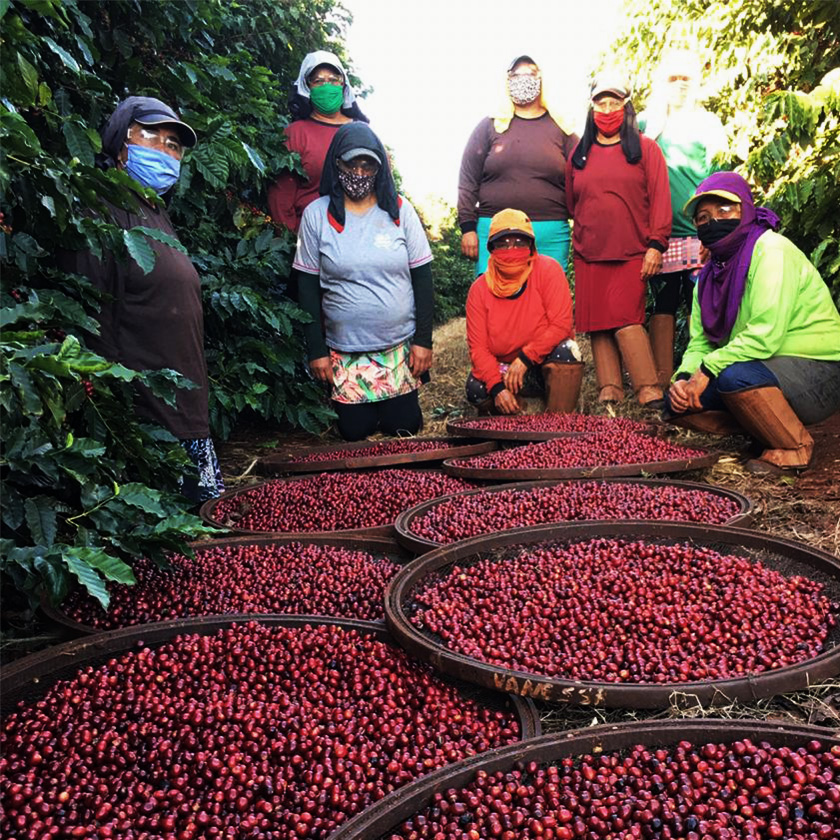Entrevista a Luiz Roberto Saldanha Rodrigues
Para obtener una perspectiva de la vida en el extremo opuesto del espectro de la altitud, hablamos con un agricultor brasileño y un evaluador Q Luiz Roberto Saldanha Director de Café en Cafés Capricornio. Su finca se llama Fazenda California, ubicada en el estado de Paraná, al sur del Trópico de Capricornio. Paraná fue una vez el centro del cultivo de café brasileño, pero como consecuencia de las severas heladas en esta región en la década de 1970 y las enormes pérdidas resultantes, la producción se desplazó hacia el norte, a un área centrada alrededor del estado de Minas Gerais, una región menos propensa a las heladas. .

Barista Hustle – What are the altitude range and latitude of Fazenda California?
Luiz Roberto Saldanha - El rango de altitud que tenemos en Fazenda California es de 600 a 750 metros sobre el nivel del mar, y nuestra latitud es de 23,25 ° sur.
BH – We understand that your region was once a big producer of coffee, but production shifted north after the ‘black frost’ of 1975. Is it your opinion that climate change has altered the climate of your state to make coffee farming safer from frost? (How do you guard against the possibility of frost?)
LRS – So from the second question. This is really hard [to answer]. There are different ways to approach it. One insight we can have about it is, 1975 was a really extreme climate event. We have registered other events that were even worse than 1975. For example, there was the frost of 1911 or -12, at the beginning of the century). The temperatures were much colder than 1975, but because there was not so much coffee planted at that time, the damage was not as destructive as it was [in 1975], because the problem is that you have coffee in a huge part of this state. It was the main exportation product for the country and for the state of Parana, and it was really devastating to the economy by being a tree that took a lot of time to be planted and start producing. It’s not like having an annual crop like soya bean or maize or wheat. That can have a frost. You lose, and you plant again. The investment for making coffee fields is really high. When you lose, it’s catastrophic, and the way the frost killed the trees was really catastrophic.
Entonces, cuando miramos los datos históricos, ve que tuvieron varias heladas. Buscaré [para] otros registros para compartir con ustedes. Algunos eran incluso peores que en 1975, pero en 1975 se plantó una gran cantidad de café.
The farm that we bought, Fazenda California, used to belong to an American group called Leon Anisio. I met with one of their old managers of the farm — one of the farm administrators — who told me they received a visit from some of the engineers that were involved in the building of the hydroelectric plant southwest of Parana. Because this is a giant plant, there is a massive huge lake…. These engineers were saying that because of this amount of water, this huge lake, the amount of water mass would probably change the way cold fronts came inside the state of Parana. Nowadays, when the cold fronts come from the south, they go to the west; they go to Argentina, Paraguay, even the Mato Grosso do Sul — that is a state of Brazil that is north of Parana. But because these cold fronts come to the lake, they go to the west because of the amount of water, and they do not come to the Norte Pioneiro de Panama, where we are located in Jacarasin.
Nowadays, when we see the winter in Brazil, it’s not uncommon to see cold fronts causing damage to High Mogiana, to South Minas, and not to Parana … because these cold fronts can come from the south, from the continent, and these ones are going to take the west side because of the huge … lake. Or, they can come through the ocean, and when they come through the ocean, [depending] on the angle, they will come to the continent, they will go to High Mogiana, South Minas, or even Sehab, like we had 3 years ago, and not come to Parana. Just being south is not necessarily increasing the … probability of heavy frost damage. That’s the point.
Some things can be [done] in order to avoid frost damage. The first one is using windbreakers, a barrier of trees that will block the cold wind, because this is one of the damages you have — the super-low temperature from the wind may cause damage. The second one you will need to avoid is weeds in the soil during the winter, because the sun heats the soil and then soil heats the air. So, if you have a lot of mulch, a lot of weeds, during the winter, you have a colder soil, and temperatures are going to drop much faster during the night — if it’s a frost night.
The other thing that works is increasing the salt concentration in the plants’ sap. We use spray carbonate of potassium aged 15 to 20 days during a winter, and this enables the plant to decrease the freezing point of the sap by 2 to 3 degrees [celsius]. It is really effective because most of the frosts are not really super-low temperatures. They will be around zero to -1, and a 1- or 2- or 3-degree decrease in the freezing point in the sap makes a huge difference. Another thing that can be used — but, in our case, because [our location] is really south, it’s a tricky one — is some trees in the field. The trees can block the infrared rays that will come from the soil into the air during the night. These will [work] like a cloud and will store this heat and will avoid the temperature decreasing super-fast, but on the other hand, if I had the trees blocking the sun during the day, this compensation is not 100 percent good.
Irrigation will be another one. If it’s a new or coffee trees, you can also increase the salt concentration. When the coffee trees are young — 1- or 2-year-old coffee trees — you can cover them with soil during the winter to protect them and avoid damage from the frost or the cold and then, during the spring, you take the soil from the top of the plants.
BH – The air pressure at Fazenda California is higher than on coffee farms at higher altitude. Are you aware of any changes in how coffee plants perform where they have more pressure and a thicker atmosphere surrounding them?
LRS – One of the impacts of the different air pressure: the thicker atmosphere surrounding the plants (or the thicker column of air) will make it harder for the beans to grow. Generally, lower altitudes with higher pressure have, as a result, softer beans. It’s much more difficult; so you see, the beans will have smaller screen [size] and lower [bean] density. The higher you go [in altitude], the higher the density of the beans. On the other hand, this higher pressure will give you a bigger concentration of carbon dioxide, which is really good for the plant vegetation, as you will have [more] vigorous plants.
BH – If we look at varieties such as geisha, growing at higher altitudes, it could be that some stress to the plant actually produces an improvement in coffee flavour. What do you think?
LRS – We need to have in mind the coffee origin centre … Ethiopia and Kenya. These coffees were taken first to Yemen, more or less 500 to 600 years before Christ, and they spent a lot of time in Yemen … in a kind of climate without shade, and [over time] these plants [became] different from the regional ones, so these plants can be planted in most part of the world. They still have some of their botanical and anatomical adaptations for partially shade grown, but we need to have in mind that these are not the original genetics of coffee any more.
Por otro lado, cuando tomas cafés como Geisha, todavía viejos, pero tienen mucho de este original. La composición química del ADN que da lugar a un fenotipo particular; el código genético de un rasgo particular. "class =" glossaryLink "target =" _ self "> genotipo, al igual que otros materiales silvestres de Etiopía; estos necesitan condiciones más cercanas a las de donde se originan: más sombra, temperaturas mucho más bajas que se pueden lograr con grandes altitudes. Yo no diría que es el estrés de la gran altitud lo que mejorará el sabor del café. Yo diría que es la composición química específica del ADN lo que da lugar a un fenotipo particular, el código genético de un rasgo particular ". = "glossaryLink" target = "_ self"> genotipo [de geisha, por ejemplo] - que es salvaje - que requeriría muchas condiciones más cercanas a su entorno original. Esa sería mi opinión….
BH – Are there certain varieties that perform better at lower altitudes?
LRS - No se trata solo de altitud… Existe una correlación directa entre una mayor altitud y una mejor calidad, pero de hecho, la mayor altitud no es la causa de la calidad. La causa de una mayor calidad es, de hecho, la disminución de la temperatura. La temperatura [rango] es el punto clave…. Entonces [necesitamos tener] dos temperaturas en mente cuando hablamos de café arábica: 12 grados se considera una temperatura basal para el café arábica. Si bajamos, el metabolismo casi se detiene, y 22 a 23 grados sería la mejor temperatura, por lo que la fotosíntesis neta máxima [puede estar] ocurriendo. Pero, pensando en cómo bajar la temperatura, podemos subir cada vez más. Temperatura más baja: debemos entender [que cuanto más lejos] nos alejamos de la línea del ecuador, menos altitud necesitamos para disminuir la temperatura. Debido al ángulo de inclinación de la Tierra, recibes mucha menos energía durante el otoño y el invierno, durante la maduración [de la cereza del café]. [En Fazenda California], lejos de la línea del ecuador, [ocurrirán] temperaturas más bajas principalmente durante el otoño y el invierno.
Completely different from the equatorial zones, where the sun crosses the equator line twice a year in the autumn and the spring, this sun will cross the equator line. The south and the north … receive much more energy, and then you need to go higher to decrease the temperature and even block some ultraviolet rays with some shade; it depends where you are. So, having this is mind, it’s not about lower altitudes, it’s ‘where is this lower altitude’? So, a lower altitude near the Equator [for example] 600 metres in Columbia, is completely different from 600m at the Tropic of Capricorn or the Tropic of Cancer. So here [in Parana] the temperatures during maturation are quite low.
Para nuestras condiciones, Mundo Novo va muy bien, Catuai, Obata… hoy tenemos Arara, es una nueva variedad de Brasil. Y hay algunos agricultores brasileños que están trayendo algunos materiales [híbridos] diferentes. Brasil tiene una restricción política estricta contra los materiales de café de los extranjeros, y el acceso es realmente difícil, por lo que dependemos de la genética brasileña [de plantas de café de raza]. Una de las razones es proteger la genética brasileña de la contaminación con plagas o enfermedades que puedan ser importadas de otros países. Básicamente, no se trata de variedades para altitudes más bajas; se está adaptando para que esta variedad pueda tener el tiempo y la energía adecuados para que la maduración del grano tenga una buena amplitud térmica, para que tenga fotosíntesis neta durante el día y una temperatura baja durante el día. la noche para disminuir el metabolismo almacenado en azúcares y ácidos orgánicos. Entonces, este es el punto para comprender dónde se encuentra, la interacción entre la altitud y la latitud, y luego vamos a [seleccionar una planta adecuada] variedad para tener la maduración en este período del año, para tener las mejores condiciones para el maduración y cosecha.
BH – If coffee farmers were to relocate from Minas Gerais down to Parana, what, if anything would they need to change about the way they farm?
LRS - Paraná tiene un clima que se clasifica como subtropical. Para nosotros, subtropical significa que tenemos cuatro estaciones, diferentes de las zonas ecuatoriales o climas tropicales, donde hay seis meses de lluvia y seis meses de estación seca. En Paraná, por ser un clima subtropical, tenemos lluvias casi todo el año. Durante la cosecha y poscosecha, es similar a algunas tierras altas de Centroamérica, con temperaturas súper bajas, mucha humedad y días nublados. Una gran diferencia es Paraná durante los períodos de floración de primavera: tenemos una gran amplitud térmica y mucho viento. Esta es una temporada de transición y, como estamos cerca del sur, recibimos una gran cantidad de vientos; este es un comportamiento [típicamente característico de las] montañas. Montañas en Brasil, tierras altas de Brasil, tierras altas de América Central: tienen esta gran amplitud térmica y mucho viento, y hay una gran cantidad de enfermedades durante el período de floración. Por lo tanto, estos necesitan técnicas agrícolas completamente diferentes. Luego, cuando llegamos al verano, tenemos mucha energía, mucha lluvia y temperaturas más altas, y luego [el clima] se comporta como [el de] tierras bajas, una especie de clima tropical. Es muy bueno para el período vegetativo. Pero esto [requiere] mucho manejo técnico y profesional en nutrición, manejo de plagas y enfermedades, y manejo de malezas.
Luego, cuando lleguemos al Otoño - la maduración - debemos tener en cuenta que nuestra cosecha se hará en medio de algunas lluvias, preservando esta zona; preservando la estructura del frijol y la cáscara; aumentando los niveles nutricionales de calcio y borem; para la integridad de las paredes celulares y evitando malas fermentaciones . Área foliar para evitar el impacto de las lluvias el manejo de la mosca de la fruta, de la broca , del ácaro porque cualquier daño que tengas en la cáscara [y] tengas las lluvias, esto te va a abrir la puerta a la mala fermentación y para enfermedades. Es necesario tener un cuidado intenso de la fruta para tener unas cerezas perfectas durante la maduración. Y, durante la cosecha y la poscosecha, sabiendo que su ventana es muy corta, necesita realizar una recolección selectiva varias veces para asegurar la mayor cantidad de cerezas. Necesita tener técnicas de poscosecha, sabiendo que las temperaturas son bajas. Esta mojado. Es muy difícil de secar y es necesario tener una infraestructura realmente buena en el molino húmedo y el secado para garantizar cafés de alta calidad. Por lo tanto, es un entorno desafiante con un gran potencial, pero que necesita mucha adaptación y gestión profesional.
Imágenes: Luiz Roberto Saldanha y su familia.



